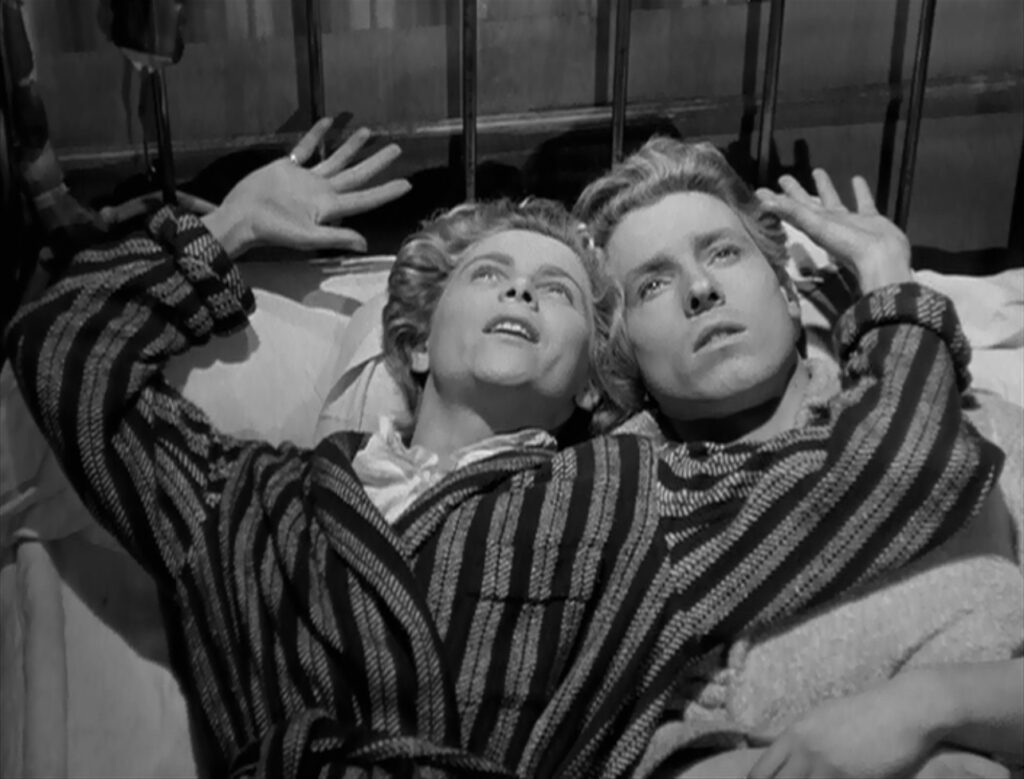
Les enfants terribles
1950, directed by Jean-Pierre Melville
Toward the end of Les enfants terribles when Paul and Élizabeth discuss the return of Agathe and Gérard, the shot sequence breaks a cardinal rule of editing. Cutting back and forth between brother and sister, it always shows the character who is not speaking. After seven shots of their motionless faces, the eighth shot settles on the mustachioed bust that has decorated their room since the old apartment. This last shot puts a point on the first seven – the sequence has effectively turned Paul and Élizabeth into living statues.
Living statues are a trademark of the film’s writer Jean Cocteau, who put them in his own films The Blood of a Poet and Beauty and the Beast. The image is fitting because classical statuary evokes ancient Greece, like so much else in Les enfants terribles – the tragic plot, the chorus-like voice-over, Élizabeth’s attempt to cultivate a “Greek profile” with a clothespin on her nose. The actors appear to be cast for their adherence to ancient Greek standards of beauty, and the story is a primal mix of incest, bisexuality, love, betrayal, and revenge. The film is about as close as cinema gets to ancient Greek drama, which is surely no accident. While Jean-Pierre Melville was adapting this novel of Cocteau’s, Cocteau was filming the Greek legend of Orpheus. What’s most Greek about this film however is its psychological acuity.
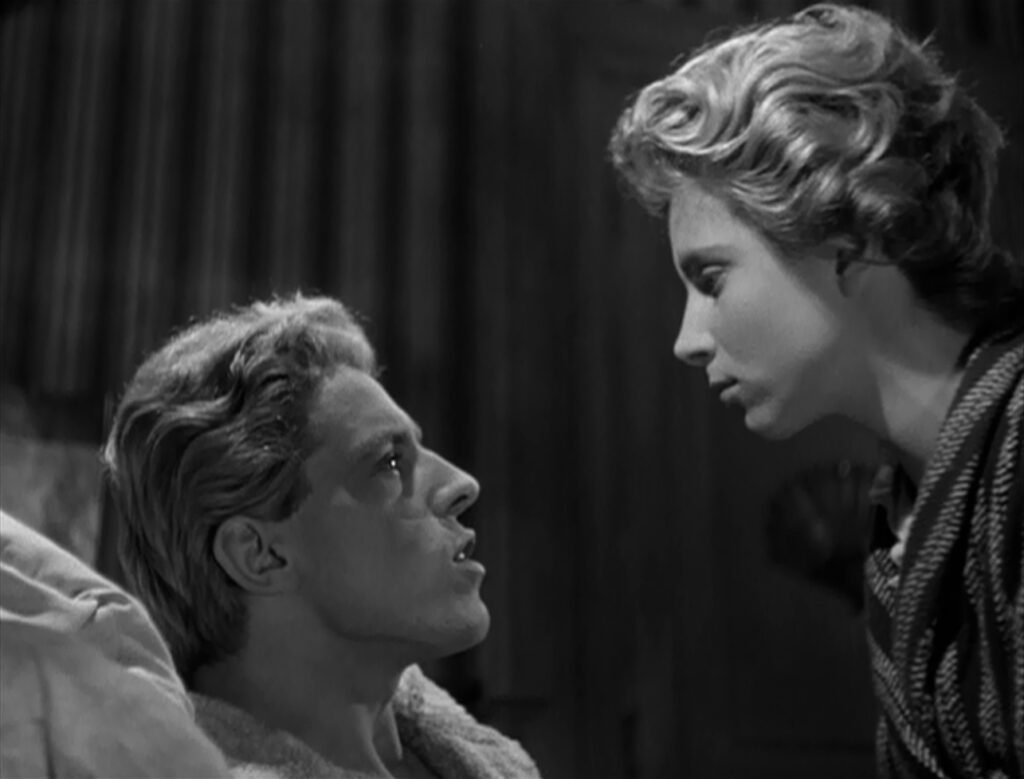
Like a Greek play, Les enfants terribles unfurls an extraordinary chain of events that captures something recognizable about human life. The schoolyard opening foretokens a film about childhood, and without being too literal about it, the movie is uncannily true to the passions and follies of early youth – its longings and attachments, its resilience and fantasy. In the closing passage of the first scene, when Paul comes home with Gérard in the cab, the voice-over says, “Young people imagine the worst right away, yet the worst seems unreal to them, since they’re unable to imagine death.” Almost every scene is filled with the paradoxes of new life, when things appear wondrous and routine at the same time. Élizabeth, we’re later told, “was used to miracles, so they came as no surprise.”
The movie does not seem to span a long time, roughly a few weeks as Paul recovers from a chest injury inflicted in a snowball fight. The characters do not change physically, even in their hair or make-up, and the film is almost as compressed in space as it is in time, only occasionally leaving the two homes. Paradoxically however it seems to encompass a wide swath of life, crossing numerous milestones in its brief span. The children’s mother dies, they travel for the first time, Élizabeth gets her first job, she gets married and widowed, she becomes a wealthy heiress, Paul falls in love, Gérard and Agathe get married, Dargelos becomes a traveling businessman, and both main characters commit suicide. Toward the beginning we hear that Paul is sixteen years old, but toward the end he tells his sister he’s “too old” for their private game.
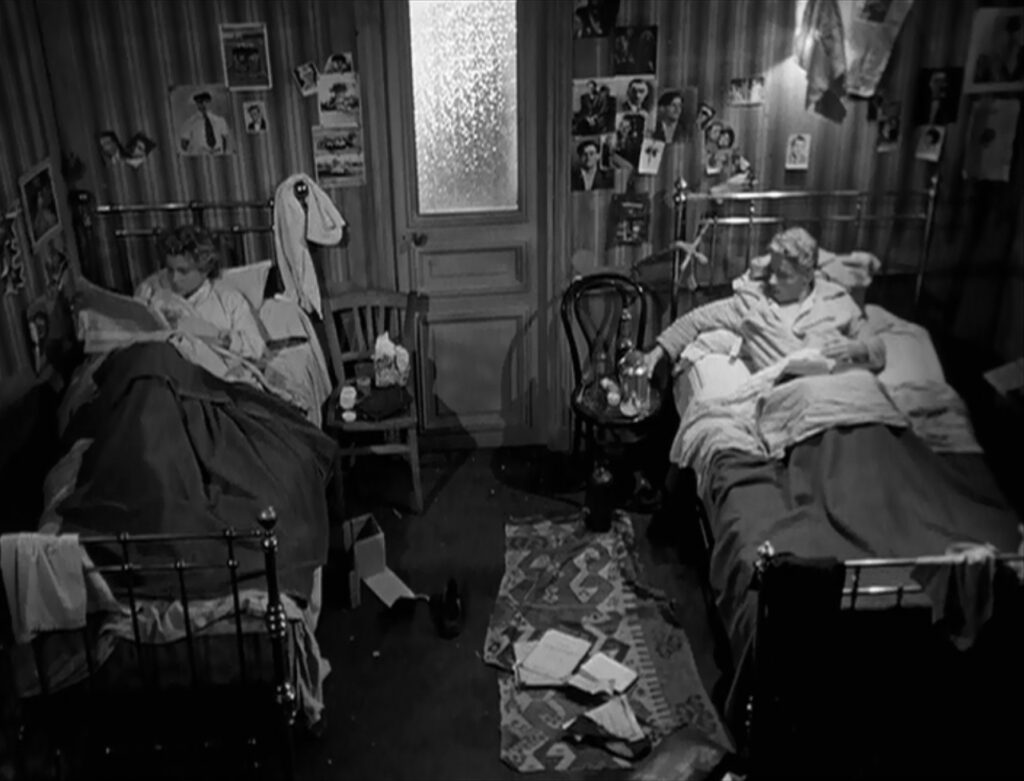
More than this paradoxical sense of time, the real paradox is that Paul and Élizabeth appear to be children and adults simultaneously. It’s not that they’re merely on the cusp of adulthood (all four leads were in their twenties), but that they always carry this dual nature. Even so, the balance shifts about 61 minutes in when they move from their mother’s apartment at 34 rue du Rocher to the 18-room mansion near the Arc de Triomphe. In the first (somewhat longer) half they occupy the roles of children: they go to school, live with their mother, need the care of a nurse, and Gérard’s uncle chaperones them to the seaside. Élizabeth finds work as a department store model, but it’s a job suited for a young woman about to enter adulthood. In the second half they live on their own, Élizabeth has money, and the nurse is no longer needed. When Michael croons a nightclub song at the piano, the tone of the film shifts. In summary, the two parts of Les enfants terribles correspond to childhood and adulthood, even as the characters blend qualities of both.
Despite the difference in tone, many symmetries link the two parts. At the beginning Dargelos incapacitates Paul with a snowball; at the end, with snow again falling outside, his ball of poison kills Paul. The master of the home dies in each half (the mother then Michael), leaving the children in charge. In each half Paul walks in his sleep, Élizabeth tries to hypnotize her brother, and Paul twirls a rack of postcards or a rack of pool cues. Apart from Dargelos’ two fateful balls, the most striking symmetry is the coming back to life of the original bedroom in the mansion’s grand gallery, with the same furniture and drawer of treasures behind bamboo screens.
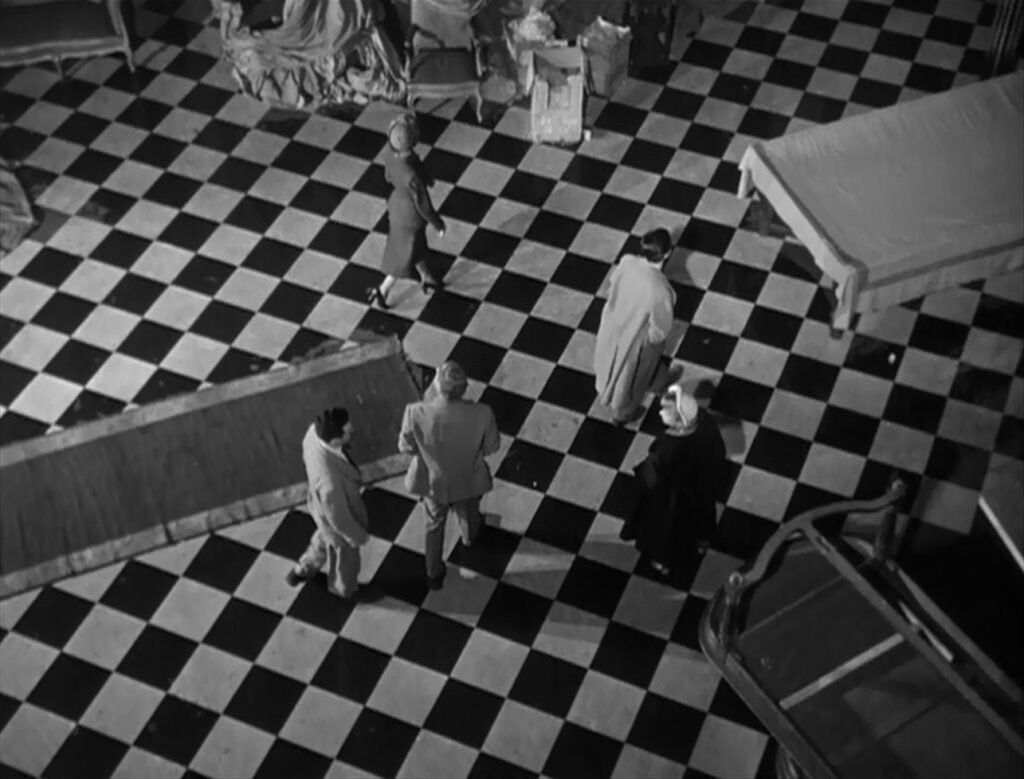
The title reveals the deeper point. In most European languages, an “enfant terrible” is an unorthodox person of talent who upsets the established order, e.g. a strong-willed artist or public figure who doesn’t respect the status quo… but that has almost nothing to do with this story or these characters. The protagonists may be unorthodox, but they don’t have the status to upset any prevailing order. Their social circle is too small. The literal meaning “terrible children” doesn’t fit either… the movie is hardly moralistic. In light of the film’s structure, however – the two echoing parts representing childhood and adulthood – another meaning presents itself. Everything that made the characters so childlike in the first half turns deadly serious in the latter half. Once they grow up, Paul and Élizabeth are terrible at being children.
A snowball, for instance, is a childhood plaything that occasionally causes injury, but its counterpart, the ball of venom, proves fatal. When Paul first sleepwalks Élizabeth teases him, but the second time she’s working to destroy his life. She follows him like a predator then washes her hands like Lady Macbeth. All the meanness in the first half has an innocence about it – petty insults, battles of will, shoplifting, making faces at a little girl – but in the second half this same behavior turns murderous. When Élizabeth first tries to hypnotize her brother, he falls asleep, but the second time he dies. The children know suicide only from the catechism (“Suicide is a mortal sin” scrawled on the mirror), but as adults suicide becomes both real and tragic.
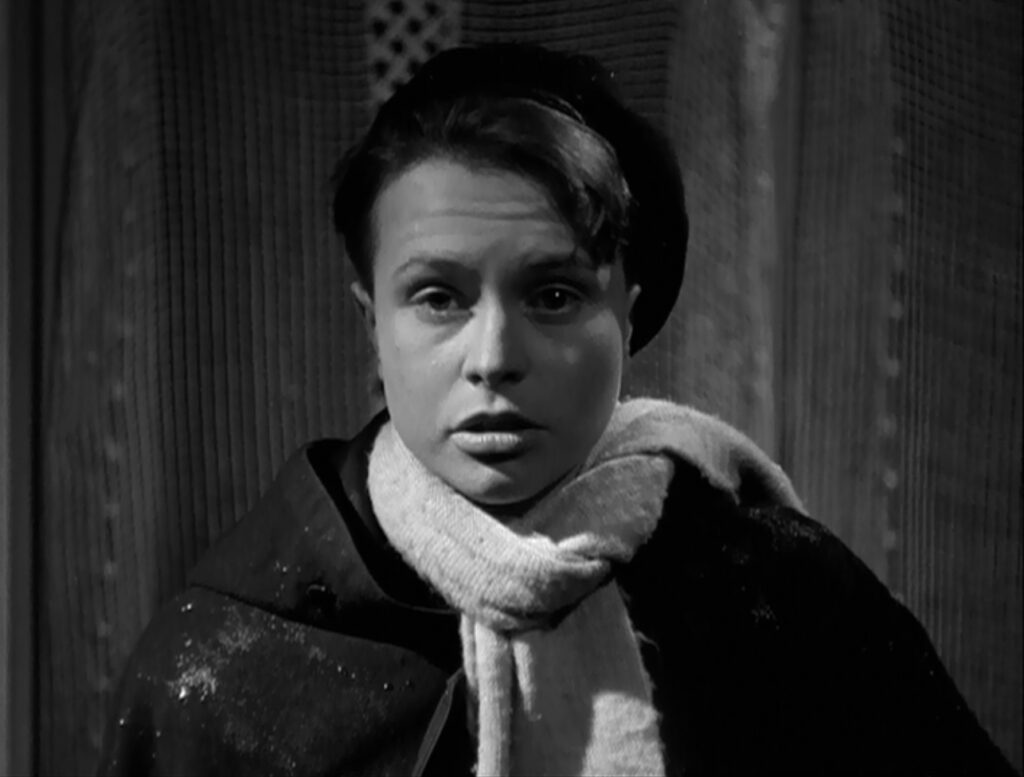
Whatever was amusing, innocent, or strange in childhood thus turns fatal in adulthood – but all these examples are mere reflections of the one change that defines growing up, for the ancient Greeks as well as for many of history’s poets, dramatists, philosophers, and psychiatrists. A child’s intra-family bonds, flavored by excitement and longing, which are so natural and matter-of-course in early life, have a way of turning poisonous in adulthood. These bonds form a template for adult sexuality, but if they remain insufficiently transformed after puberty, they take on the perverse character that Paul and Élizabeth illustrate so well. When they first they “turn on” together in the bedroom, the incestuous quality of their game is ambiguous because they’re still supposed to be children; but in the mansion it’s understood that they’re too old for that game, and the bond that attracts Élizabeth to her brother drives her to murderous jealousy.
That much of the children’s incest is plain enough. What’s less obvious is how closely Paul’s attraction to Dargelos and Agathe fits the mold of oedipal incest. First he yearns for the person who wounded him, then he transfers that yearning to one who reminds him of the first – just as a child may desire a parent above all else in the world, regardless of that parent’s infliction of punishments, and later seek that parent in other people. It’s not a trivial detail that when Agathe moves into the apartment she occupies the mother’s bedroom.
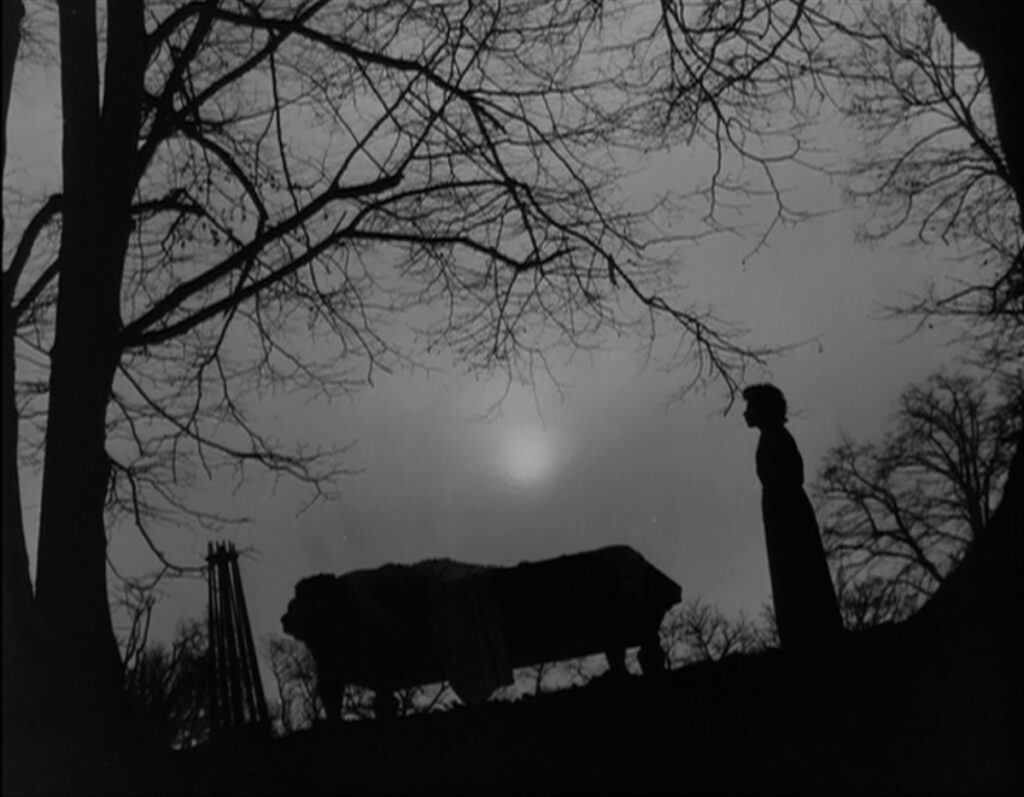
When the characters walk through the mansion, especially the gallery where the womb-like bedroom re-emerges, their voices echo in the voluminous space. Les enfants terribles captures something universal about the echo of childhood that resounds in every adult. Like Paul and Élizabeth, we carry our childhood selves within us, but lest we unleash the forces that compel these characters to their tragedy, we must appreciate that adults are terrible custodians of their inner child, and act accordingly. We can treasure the whimsy and wonder that remain in us from infancy, but if we indulge all of our childhood habits, the nastiness and possessiveness, then this film will be a window into our unhappy fate.
CONNECTIONS:
The Blood of a Poet – Snowball fight and Dargelos’ loaded snowball; allusions to Greek drama
Beauty and the Beast – Story governed by transformations; living statues
Les parents terribles – Lingering presence of childhood in adults; allusions to Greek tragedy
The Third Man – Continuum between childhood and adulthood
Orphée – Filmed concurrently with Cocteau’s involvement; allusions to ancient Greek myth or drama
Vertigo – Distorting effect of childhood incestuous longings on adult life